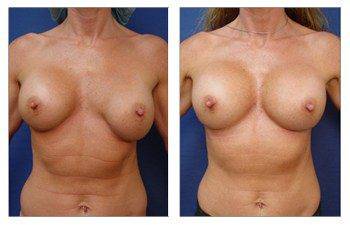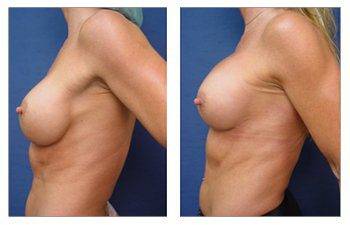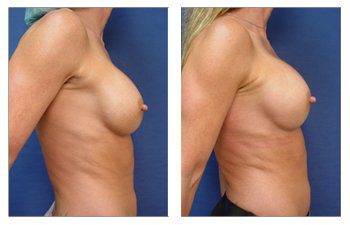



Download SurgiSculpt’s free Liposuction eBook
Breast Augmentation Revision Surgery Introduction
Breast augmentation revision surgery is coined to describe patients who have already undergone breast augmentation, but desire one of the multiple breast revisions that may include breast implant removal, breast implant exchange, capsule modification, breast pocket alteration, and/or breast lift.
Implant Reasons for Breast Augmentation Revision Surgery
Breast implants may require removal if the patient wishes to have larger breasts following initial augmentation. When you are younger and thinner, a particular implant size may be appropriate. However, as you age and gain weight, your breasts may not appear as large as they once had. In contrast, as patients get into their elder years, they often desire to downsize their implant size since they are tired of carrying the weight of the implants for several decades.
Another set of patients may desire to have implant explantation and no replacement of implants at all. This has become popularized by patients promoting breast implant illness syndrome.
The final reason patients may require implant exchange is due to implants that have ruptured or following the development of capsular contracture. Implant rupture can be diagnosed clinically in patients who have saline implants as their breasts will deflate much like a tire over a two-week period.
For silicone implants, the deflation time is dependent on the severity of the rupture. Silicone implant ruptures can be much more subtle initially. This is because even despite a rupture of the shell, the silicone jelly tends to be kept within the formed scar tissue around the implant called the capsule.
Interestingly, a large number of silicone implant ruptures are diagnosed following the age of 40 when patients start to have annual or every other year mammograms. A ruptured implant is often detected on mammography and can be confirmed by MRI if mammography is unequivocal.
Capsular contracture a reason for Breast Augmentation Revision Surgery
In breast augmentation revision surgery, capsular contracture refers to the development of a thickened capsule scar around the implants. The reason for the capsule thickening is multifold. There is an early capsular contracture caused by contaminants such as powder in the surgical glove, bacterial contamination, or bleeding into the breast pocket.
A more common cause of capsular contracture is microscopic oozing of the silicone jelly out of the implant shell which occurs over decades following micro-tears of the outer shell.
This type of oozing of the silicone molecules is called bleeding and will result in the thickening of your breast implant scar, termed capsular contracture. To treat capsular contracture one of two maneuvers may be necessary including releasing the capsule, termed capsulotomy, or cutting out the capsule, termed capsulectomy.
Implant Malposition a Reason for Breast Augmentation Revision Surgery
If the implant position has become malpositioned, then breast augmentation revision surgery will be recommended. A malpositioned implant can be positioned too high, too low, or lateralized. When implant malposition has occurred, the breast pocket will have to be readjusted so that the implant is centered on the nipple and areola.
In order to reposition the breast implant pocket, the capsule that has already formed is utilized. This capsule can be incised, cut out, or modified by being sewn up, termed capsulorrhaphy.
This maneuver is very common during breast augmentation revision surgery, where major and even minor pocket adjustments are desired. The final patients who may desire breast augmentation revision surgery include patients who have had successful breast augmentation decades but have noticed sagging of their breasts due to the natural aging process.
These patients are typically happy with their implants but wish to have their breasts and nipples raised to a more youthful position so they opt to have the breast augmentation revision surgery. Since their implants are usually several decades old, these patients universally elect to have their implants replaced during their breast lift surgery.
Breast Sagging a Reason for Breast Augmentation Revision Surgery
A final reason why patients may seek breast augmentation revision surgery is if their breast mounds have started to sag. This occurs following years of daily living as the weight of the implants further compounds the pulling down of the breast mounds due to the effects of gravity. Patients will notice breast and nipple sagging most often following childbirth and breastfeeding.
Understanding Breast Augmentation Revision Surgery
Breast augmentation is one of the most popular cosmetic surgeries globally. However, like any surgical procedure, there might come a time when a revision becomes necessary, either due to complications, aesthetic reasons, or personal choice. Let’s delve into what breast augmentation revision surgery is, why it’s required, and what to expect.
The Need for Revision Surgery
Personal Aesthetic Choices
Over time, a woman’s aesthetic preferences might change. What seemed appealing in one’s twenties might not hold the same charm in one’s forties. It’s natural for someone to seek a different breast size or shape as they age, and a revision surgery allows for such adjustments.
Changes After Life Events
Significant life events, such as pregnancy, weight fluctuations, or aging, can impact the appearance and feel of augmented breasts. Sometimes, these changes can lead to dissatisfaction with the results of the initial augmentation, warranting a revision.
Complications or Unsatisfactory Outcomes
While breast augmentation is generally safe, complications can arise. Capsular contracture, implant rupture, or asymmetry are among the potential issues. In some cases, the initial surgery might not yield the desired results, or there could be dissatisfaction with implant placement or size.
Types of Revision Procedures
Implant Exchange
This involves replacing old or damaged implants with new ones. This could be due to a desire for a different size, a switch between saline and silicone, or addressing issues like implant rupture.
Capsulectomy or Capsulotomy
For patients experiencing capsular contracture (hardening of the tissue around the implant), these procedures are beneficial. Capsulectomy involves removing the scar tissue, while capsulotomy is the surgical release of the tightened capsule.
Implant Repositioning
Sometimes, the implant might need to be repositioned due to cosmetic dissatisfaction or complications. This procedure ensures the implant is situated correctly within the breast pocket.
Preparing for the Surgery
As with the initial augmentation, proper preparation is crucial for a successful revision surgery. Start by researching board-certified plastic surgeons who specialize in breast surgeries. The American Society of Plastic Surgeons can be an excellent resource for finding qualified professionals.
Have an in-depth consultation, discussing your goals, concerns, and expectations. This dialogue ensures both you and the surgeon are on the same page and minimizes potential misunderstandings.
Recovery and Post-Op Care
The recovery period might vary based on the type of revision surgery. However, some general guidelines include:
Adequate Rest
It’s crucial to give your body time to heal. Avoid strenuous activities, and heavy lifting, and ensure you’re getting plenty of sleep.
Follow Post-Op Instructions
Your surgeon will provide specific guidelines, including wound care, medications, and potential exercises. Adhering to these instructions will promote quicker recovery and reduce the risk of complications.
Regular Check-ups
Schedule and attend all follow-up appointments with your surgeon. These check-ups allow for monitoring of the healing process and early identification of any issues.
For more information on the subject, surgisculpt offers an in-depth guide and resources on breast surgeries and associated care
In Conclusion Breast Augmentation Revision Surgery
Breast augmentation revision surgery provides an avenue for individuals to address concerns after their initial augmentation, whether those concerns are aesthetic or related to complications. As always, thorough research and open communication with a trusted surgeon are key to ensuring the best possible outcome.
Please see this 44-year-old female before and after her breast augmentation revision to correct her asymmetry.
